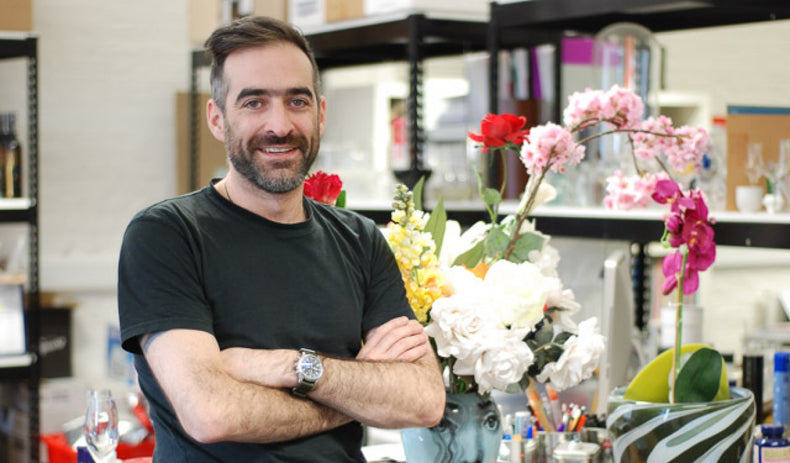Tony Conigliaro: Pushing The Boundaries

The partition cutting through the cocktail development laboratory, The Drinks Factory, is lined with jars. Sichuan peppercorns, dried lime, hibiscus, verbena, borage and wormwood. From one side, it seems like a seventeenth century apothecary. Drifting through the partition though is a familiar, twenty-first century whirr. The mechanic buzz from a centrifuge, a rotary evaporator, vacuum sealer, and pressure cooker. It’s old meets new, in a Blumenthal-esque playground.
The Drinks Factory is just round the corner from owner, Tony Conigliaro’s, award-winning cocktail bar – 69 Colebrooke Row. While his tiny ‘film noir’ joint acts as something of a shop front, it’s The Drinks Factory which is the brains behind the operation. It’s here that laboratory technicians are pushing all sorts boundaries in the world of drinks development – infusing vodka with flint stones, extracting water from olives and perfecting port reductions.
From one side, it seems like a seventeenth century apothecary. Drifting through the partition though is a familiar, twenty-first century whirr
Many might think that it’s something of an eccentric pursuit, but Conigliaro describes his journey from art historian to the Drinks Factory founder almost as if it were a logical progression. Having worked in fashion houses, Conigliaro moved into the bar industry. But it was while he was working at Knightsbridge’s Isola restaurant that he became frustrated with the poor purées available for using in cocktails. He turned to the pastry chef for advice, and the pastry chef suggested that he made his own.
It was that pear and cinnamon purée which Conigliaro used to flavour a bellini back in 1999 which kick-started his quest to find new and better and different flavours. This then developed into a serious scientific pursuit as he embarked upon bigger challenges. The two-year long project to create food-grade perfume, which involved creating a perfume-like structure which worked in a cocktail. Or the food -grade lipstick, used to mark the side of a champagne glass for his famous Sealed with a Kiss cocktail. Or making diamonds out of vermouth.
Conigliaro was frustrated with the poor purées available for using in cocktails. He turned to the pastry chef for advice, and the pastry chef suggested that he made his own.
When I meet Conigliaro, he's particularly excited by the recent discovery of a new ingredient – labdanum. “It’s a really beautiful type of balsamic resin” he explains. “It’s usually found in perfumery, but now labdanum is starting to be used in food too”. Resins and bark and even stones are all familiar ingredients on Conigliaro’s cocktail menu. They don’t have appetite-whetting associations. But it’s just this level of complexity which he finds intriguing.
“It’s all about context, and how you use an ingredient, and what you use it for” he says. “If you look at the ingredients in bitters, they’re quite disgusting. Take quinine in tonic water – it’s poisonous – but in the right amount it’s safe and has a nice bitterness to it.”
Given Conigliaro’s status as the Indiana Jones of ingredients, it’s no surprise that he dedicates a lot of time to developing new cocktails which showcase the ingredients best at 69 Colebrooke Row. It’s a time-consuming process which starts with what the art historian in Conigliaro calls a ‘reference point’ – “Paper flowers. Films. Conversations. Bits of music. Flavours. Concepts. Anything really.”
Often we just don’t have the answers to complete the project, or the process or the actual ingredients themselves
Another of Conigliaro’s bars, The Zetter Townhouse, shows how his inspiration process works. In the heart of the cocktail lounge is a portrait of an imaginary Great Aunt called Wilhelmina. It’s her storybook adventures which inspire a number of the cocktails on the menu. A nettle-based drink from one of her foraging expeditions down a Victoriana towpath, or the rum and port reduction from when she was a stowaway on a navy ship during the ‘rum ration’ era.
Once Conigliaro finds his inspiration, he sets about perfecting each element of the drink. This can take days, months, years – which is why he often has ten to twelve drinks in the development stage at any one time. “Often we just don’t have the answers to complete the project, or the process or the actual ingredients themselves” he explains.
“I might have a honey, but it’s not the right honey, so the project will be put on hold while we track it down”. He laughs as he describes the amount of olives the Drinks Factory went through as they perfected the olive water part of a Dirty Martini, which took more than 25 different attempts in the centrifuge – tweaking the spin time and temperature each time.
If you change an ingredient, you need to be careful not to unbalance the cocktail, take every ingredient into account, and look for a different but direct exchange
It’s clear that The Drinks Factory’s drink development is at the extreme technical end of the scale. But Conigliaro encourages keen cocktail makers to experiment at home too. “Sugar syrups are a useful place to start, as are purées” he suggests. “After you’ve mastered those, there are bitters and liqueurs. Anything that has an everyday use in a bar is the best starting point.”
“Begin by tinkering slightly with a classic cocktail recipe” he suggests. “If you change an ingredient, you need to be careful not to unbalance the cocktail, so take every ingredient into account, and look for a different but direct exchange.” Conigliaro explains. “Take a margarita – if you switch triple sec for something else, you’ve got to take into account the sweetness and the flavour profile of whatever you switch it for.”
Laughing about his ‘Rose’ cocktail, which took two years to perfect, Conigliaro’s parting piece of advice rings true– which is that, most of all, developing a new cocktail is a process which shouldn’t be rushed.
69 Colebrooke Row
London
N1 8AA


